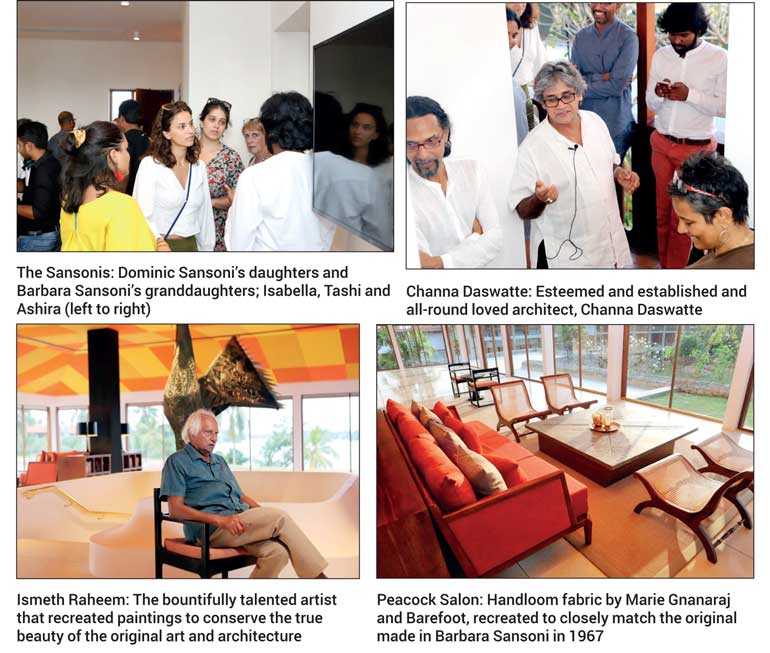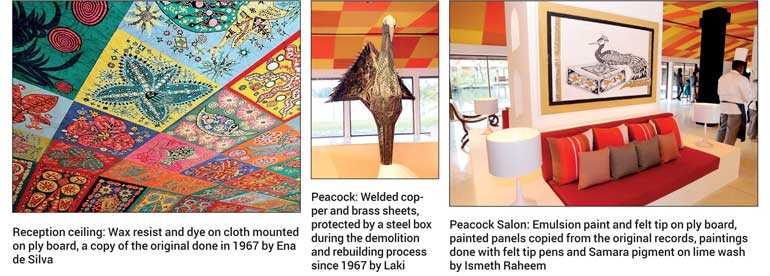Thursday Feb 20, 2025
Thursday Feb 20, 2025
Monday, 13 January 2020 09:15 - - {{hitsCtrl.values.hits}}





Cinnamon Bentota Beach hosted a special pre-opening exposition of the resort on 5 January to ardent followers of Geoffrey Bawa, art enthusiasts and the press to showcase the artwork set up in the restored section of the hotel.
The Bentota Beach Hotel was originally built in 1967 as a part of tourism development encouraged by the Government of Sri Lanka. Designed by Geoffrey Bawa, it was said to be a new type of design envisioned for the first time in Sri Lanka and perhaps in all of Asia as a precedent to the whole Asian style of architecture now known as the tropical modern style that engages with local material connected to the locality.
In 2017, 50 years after it first opened to the public, the hotel was closed and all parts that could be removed were dismantled. In finishing the building, the decision was taken to go back to the original finishes used by Bawa including its terrazzo floors and timber doors and windows.
Moreover, it was decided to remake the famous ceiling by Ena de Silva that adorned the entrance and also to reinstate the handloom fabric ceiling designed by Barbara Sansoni and Barefoot. Using old photographs and drawings from the Geoffrey Bawa archive, the design has managed to replace the concierge table and the art redrawn by Ismeth Raheem, and even conserve a few more that still existed. It also used copies of the initial furniture designed by Bawa to furnish the lobby and lounges.
The reception ceiling of multiple batik panels was recreated under the guidance of Chandra Aluvihare, Director of the Aluvihare Heritage Centre, Architect Amila de Mel and Designer Roshan Rajapakse as a copy of the original. Brass panels on the copper backdrop of the lift doors, reminiscent of the then fashionable designs of the Scandinavian designer Marie Mekko, were designed by the architect Anura Ratnavibhushana who was at the time, working in the studio of Geoffrey Bawa.
The panels rebuilt are a copy of the original made in the 1990s to fit the then replaced lift. The ceiling of the Peacock Salon and bar formerly covered in handloom, was recreated with aid of designer Marie Gnanaraj using the archival records of both the Bawa Trust and Barefoot to closely match the original.
Painted wall panels of the Peacock Salon were copied from the records kept by Ismeth Raheem. It was first done as a low cost way of using art to decorate the walls of the salon with clear instruction from Geoffrey Bawa to only use felt tip pens and Samara pigment on limewash. The Peacock at the top of the main staircase made by Laki Senanayake is the original that has stood there since the hotel’s inception and was protected by a steel box during the demolition and rebuilding process, and then cleaned and repaired by artist Pradeep Manampari.
A gilded and painted panel by Ismeth Raheem on the south wall of the Peacock records memories of the Bentota Beach Hotel and its 50-year history. Ceiling and wall panels of the check-out lounge has cutwork plastic panes paced on the ceiling and walls to evoke the original design used by Bawa when it previously functioned as an all-day dining space.
In designing the accommodation, it was decided to convert the 30 rooms into 16 suites containing artifacts and art that correspond to the name of each suite. Eight artists were commissioned to depict and record what they felt the name of the suite meant to them. Each suite has a main piece of artwork on the wall of the living room and several others in the bathrooms and dressing areas. Additionally, six archival Barefoot fabric designs by Barbara Sansoni were selected to be displayed behind the bed heads while the cushions were specially designed and woven by Asanga Godamune.
Channa Daswatte, commenting on the resort’s monumental refurbishment, concluded: “Today, as the Cinnamon Bentota Beach stands poised to open its doors to another generation of guests and hopefully into its next 50 years, it stands also as a repository of art of both a past age and of today. Art and its public creation and appreciation is a critical component of a modern society and it is admirable that John Keells Holdings has once again stood by its commitment to the arts.”
Discover Kapruka, the leading online shopping platform in Sri Lanka, where you can conveniently send Gifts and Flowers to your loved ones for any event including Valentine ’s Day. Explore a wide range of popular Shopping Categories on Kapruka, including Toys, Groceries, Electronics, Birthday Cakes, Fruits, Chocolates, Flower Bouquets, Clothing, Watches, Lingerie, Gift Sets and Jewellery. Also if you’re interested in selling with Kapruka, Partner Central by Kapruka is the best solution to start with. Moreover, through Kapruka Global Shop, you can also enjoy the convenience of purchasing products from renowned platforms like Amazon and eBay and have them delivered to Sri Lanka.
Discover Kapruka, the leading online shopping platform in Sri Lanka, where you can conveniently send Gifts and Flowers to your loved ones for any event including Valentine ’s Day. Explore a wide range of popular Shopping Categories on Kapruka, including Toys, Groceries, Electronics, Birthday Cakes, Fruits, Chocolates, Flower Bouquets, Clothing, Watches, Lingerie, Gift Sets and Jewellery. Also if you’re interested in selling with Kapruka, Partner Central by Kapruka is the best solution to start with. Moreover, through Kapruka Global Shop, you can also enjoy the convenience of purchasing products from renowned platforms like Amazon and eBay and have them delivered to Sri Lanka.